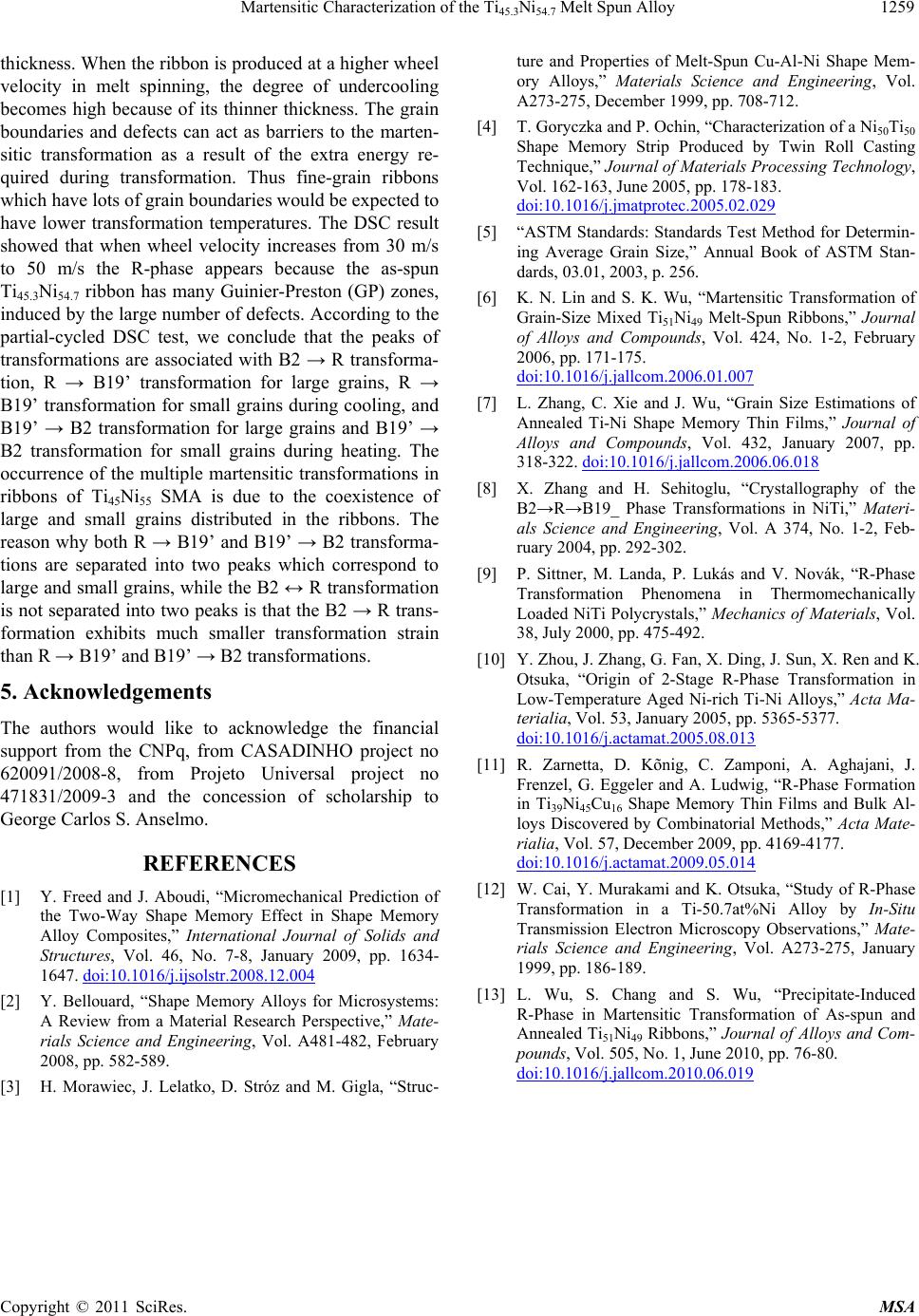
Martensitic Characterization of the Ti45.3Ni54.7 Melt Spun Alloy
Copyright © 2011 SciRes. MSA
1259
thickness. When the ribbon is produced at a higher wheel
velocity in melt spinning, the degree of undercooling
becomes high because of its thinner thickness. The grain
boundaries and defects can act as barriers to the marten-
sitic transformation as a result of the extra energy re-
quired during transformation. Thus fine-grain ribbons
which have lots of grain boundaries would be expected to
have lower transformation temperatures. The DSC result
showed that when wheel velocity increases from 30 m/s
to 50 m/s the R-phase appears because the as-spun
Ti45.3Ni54.7 ribbon has many Guinier-Preston (GP) zones,
induced by the large number of defects. According to the
partial-cycled DSC test, we conclude that the peaks of
transformations are associated with B2 → R transforma-
tion, R → B19’ transformation for large grains, R →
B19’ transformation for small grains during cooling, and
B19’ → B2 transformation for large grains and B19’ →
B2 transformation for small grains during heating. The
occurrence of the multiple martensitic transformations in
ribbons of Ti45 Ni55 SMA is due to the coexistence of
large and small grains distributed in the ribbons. The
reason why both R → B19’ and B19’ → B2 transforma-
tions are separated into two peaks which correspond to
large and small grains, while the B2 ↔ R transformation
is not separated into two peaks is that the B2 → R trans-
formation exhibits much smaller transformation strain
than R → B19’ and B19’ → B2 transformations.
5. Acknowledgements
The authors would like to acknowledge the financial
support from the CNPq, from CASADINHO project no
620091/2008-8, from Projeto Universal project no
471831/2009-3 and the concession of scholarship to
George Carlos S. Anselmo.
REFERENCES
[1] Y. Freed and J. Aboudi, “Micromechanical Prediction of
the Two-Way Shape Memory Effect in Shape Memory
Alloy Composites,” International Journal of Solids and
Structures, Vol. 46, No. 7-8, January 2009, pp. 1634-
1647. doi:10.1016/j.ijsolstr.2008.12.004
[2] Y. Bellouard, “Shape Memory Alloys for Microsystems:
A Review from a Material Research Perspective,” Mate-
rials Science and Engineering, Vol. A481-482, February
2008, pp. 582-589.
[3] H. Morawiec, J. Lelatko, D. Stróz and M. Gigla, “Struc-
ture and Properties of Melt-Spun Cu-Al-Ni Shape Mem-
ory Alloys,” Materials Science and Engineering, Vol.
A273-275, December 1999, pp. 708-712.
[4] T. Goryczka and P. Ochin, “Characterization of a Ni50Ti50
Shape Memory Strip Produced by Twin Roll Casting
Technique,” Journal of Materials Processing Technology,
Vol. 162-163, June 2005, pp. 178-183.
doi:10.1016/j.jmatprotec.2005.02.029
[5] “ASTM Standards: Standards Test Method for Determin-
ing Average Grain Size,” Annual Book of ASTM Stan-
dards, 03.01, 2003, p. 256.
[6] K. N. Lin and S. K. Wu, “Martensitic Transformation of
Grain-Size Mixed Ti51Ni49 Melt-Spun Ribbons,” Journal
of Alloys and Compounds, Vol. 424, No. 1-2, February
2006, pp. 171-175.
doi:10.1016/j.jallcom.2006.01.007
[7] L. Zhang, C. Xie and J. Wu, “Grain Size Estimations of
Annealed Ti-Ni Shape Memory Thin Films,” Journal of
Alloys and Compounds, Vol. 432, January 2007, pp.
318-322. doi:10.1016/j.jallcom.2006.06.018
[8] X. Zhang and H. Sehitoglu, “Crystallography of the
B2→R→B19_ Phase Transformations in NiTi,” Materi-
als Science and Engineering, Vol. A 374, No. 1-2, Feb-
ruary 2004, pp. 292-302.
[9] P. Sittner, M. Landa, P. Lukás and V. Novák, “R-Phase
Transformation Phenomena in Thermomechanically
Loaded NiTi Polycrystals,” Mechanics of Materials, Vol.
38, July 2000, pp. 475-492.
[10] Y. Zhou, J. Zhang, G. Fan, X. Ding, J. Sun, X. Ren and K.
Otsuka, “Origin of 2-Stage R-Phase Transformation in
Low-Temperature Aged Ni-rich Ti-Ni Alloys,” Acta Ma-
terialia, Vol. 53, January 2005, pp. 5365-5377.
doi:10.1016/j.actamat.2005.08.013
[11] R. Zarnetta, D. Kõnig, C. Zamponi, A. Aghajani, J.
Frenzel, G. Eggeler and A. Ludwig, “R-Phase Formation
in Ti39Ni45Cu16 Shape Memory Thin Films and Bulk Al-
loys Discovered by Combinatorial Methods,” Acta Mate-
rialia, Vol. 57, December 2009, pp. 4169-4177.
doi:10.1016/j.actamat.2009.05.014
[12] W. Cai, Y. Murakami and K. Otsuka, “Study of R-Phase
Transformation in a Ti-50.7at%Ni Alloy by In-Situ
Transmission Electron Microscopy Observations,” Mate-
rials Science and Engineering, Vol. A273-275, January
1999, pp. 186-189.
[13] L. Wu, S. Chang and S. Wu, “Precipitate-Induced
R-Phase in Martensitic Transformation of As-spun and
Annealed Ti51Ni49 Ribbons,” Journal of Alloys and Com-
pounds, Vol. 505, No. 1, June 2010, pp. 76-80.
doi:10.1016/j.jallcom.2010.06.019